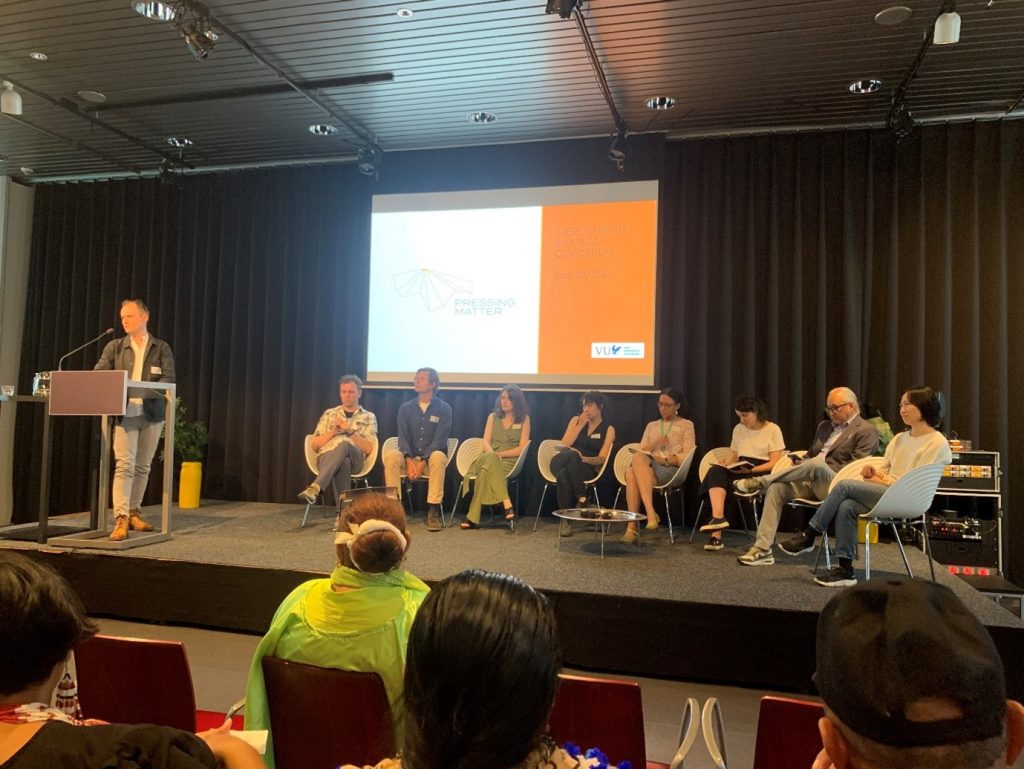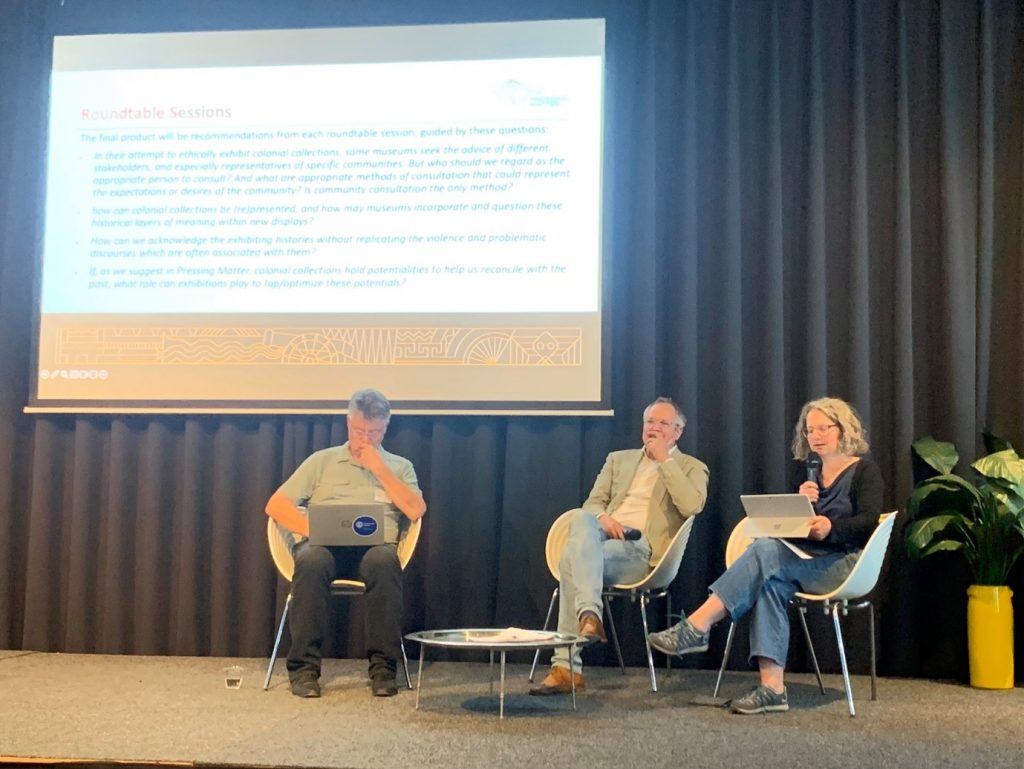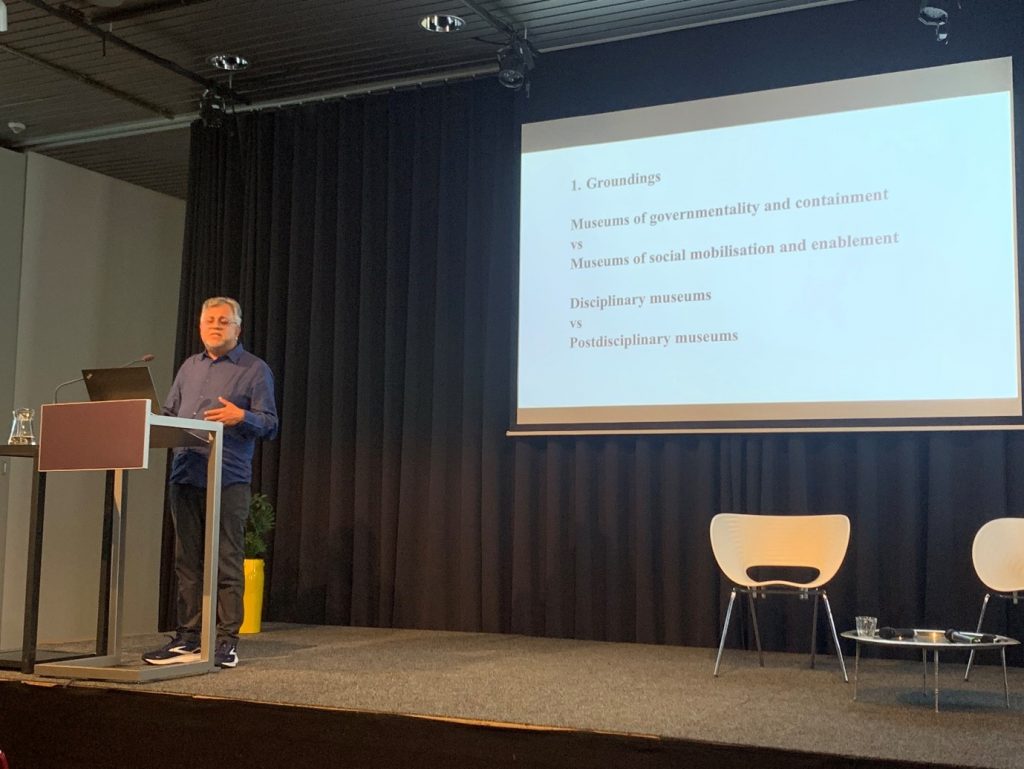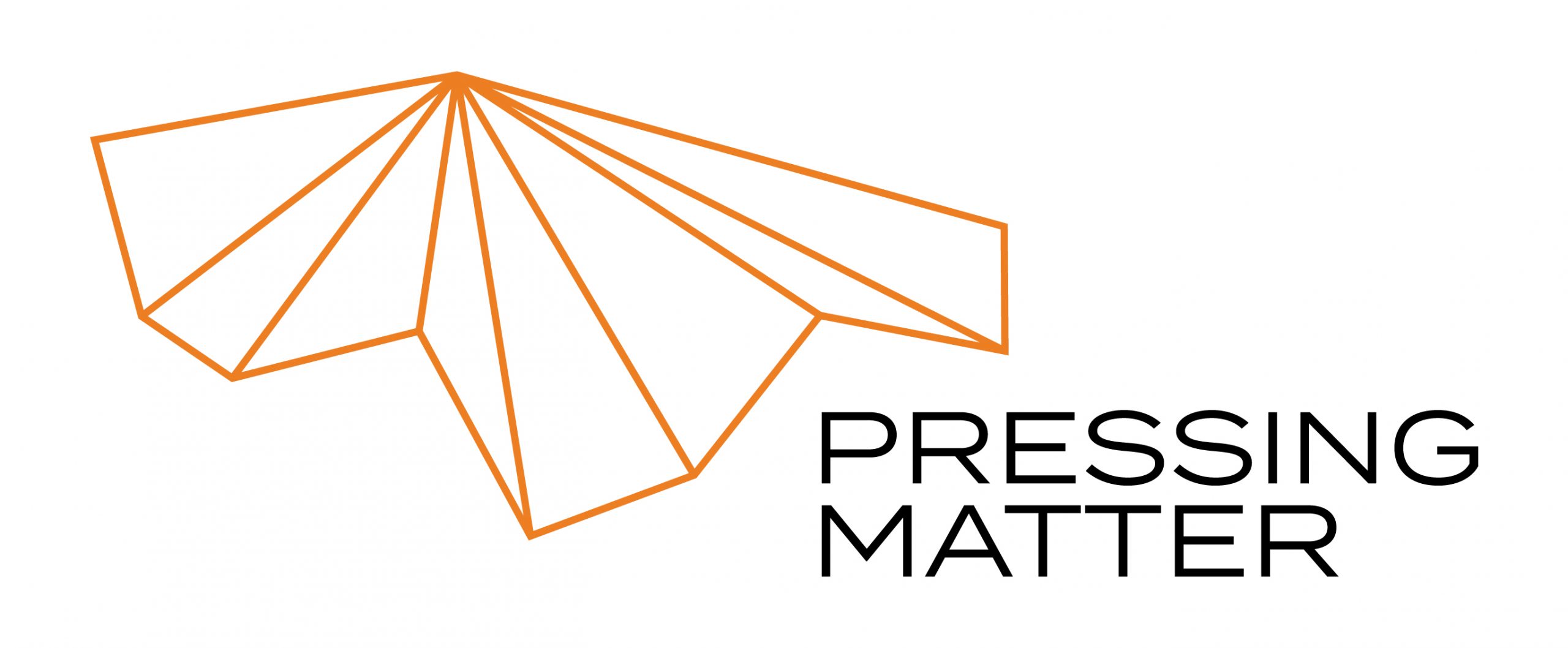Summary Pressing Matter biannual symposium 28 June 2024
(The text and images of this post are all by Dr Rosalie Hans)
On Friday 28 June 2024 the sixth biannual symposium of the Pressing Matter (PM) consortium took place at the Wereldmuseum in Leiden. As the project moves into its final year and an upcoming exhibition at the Wereldmuseum in Amsterdam, the theme was ‘Exhibiting Colonial Collections – Challenges and Possibilities. Professor Wayne Modest, PM programme leader, opened the day’s discussions with a reflection on the changes in thinking about display in the last fifteen years. Wayne asked what the ethical and political horizons of display are now, at a time when museums grapple with the colonial and racial systems at the heart of their institutions. Restating that Pressing Matter is not just about restitution, the key questions around display are; who gives, or gets, permission, and to whom? In short, what ethical work needs to be done?
Following this, Amber Aranui, curator of Te Papa Tongarewa and Critical Friend of Pressing Matter, shared some of the work that she has done in New Zealand. She noted the on-going need for in-depth collection research to regain lost histories of objects. She described how karetao (ceremonial puppets) could not be displayed to young audiences without their histories and taonga known so she commissioned new karetao made by Maori artist James Webster. Amber finds that protests held at the museum are litmus tests for the museums’ openness to change. They must be open to questioning how they are representing and where power is centered. Who is speaking? Wonu Veys, curator at the Wereldmuseum, complicated the notion of ‘community interpretation and permission’. She shared that the so-called raja ampat altar from Western New Guinea, which includes human/ancestral remains, was perceived differently by various Pacific diaspora groups during the travelling ‘Oceania’ exhibition. Wonu also asked; what is our responsibility as a museum? Should the responsibility for ethical decisions always be placed with a ‘community’, and who speaks for which group?
The morning continued with a presentation from PhD candidate Elsbeth Dekker and Harm Stevens, curator at the Rijksmuseum. They co-presented on how the law and museum collections were used to cleanse objects of the violent circumstances in which they were taken by using legal terms and euphemistic language. They advocated for ‘de-sterilizing’ the collections by showing the histories of violence behind the objects. Postdoc researcher Amélie Roussillon presented her research into how the Utrechtsche Zendingsvereeniging (UZV) exhibited the objects collected by missionaries in Western New Guinea. She found that the objects first served to promote the mission in the UZV’s museum at the end of the 19th century which was similar to travelling mission exhibitions. Stories of conversion were highlighted, although objects rarely represented these stories. When the collection moved to what is now Wereldmuseum Rotterdam their mission history was erased and ethnographic classification replaced it. However, none of these modes of display accurately represent the meanings of these diverse collections and the question is how to mobilize these objects today, and for/by whom?
After a short break, Joe Horse Capture, vice president of the Autry Museum of the American West and PM Critical Friend spoke about the opportunities and challenges for Native American tribes and museums since the implementation of the new NAGPRA law earlier this year. The new law gives more agency to tribes on whether or not their collections can be used, research and displayed and prioritizes Native traditional knowledge over anthropological sources. This puts museums in a position of stewardship (rather than ownership) and gives tribes the final say over their objects. The challenge for museums and tribes is the human capacity needed to deal with all the work arising from these changes but Joe concluded that this new approach is good for people, museums and objects; ‘they are lonely and want to be visited’. The challenges and opportunities of using virtual reality (VR) and displays in the virtual space were presented by PM PI Victor de Boer and Shenghui Wang, assistant professor at the University of Twente. With the exhibition ‘HERE: Black in Rembrandt’s time’ as a case study they asked ‘how to create a polyvocal VR space? Virtually, interaction with objects can be stimulated but every person’s actions can also be monitored to understand users’ interests. Their current study tries to measure attitudes towards diversity (or indeed, race) before and after a virtual visit to the exhibition. Could VR spaces facilitate cross-cultural dialogue? These questions, and the ethical concerns they encounter, could inform ‘traditional’ museum spaces as well. The last presenter of the morning session was PM artist-in-residence Pansee Atta whose recent work has focused on the Wereldmuseums’ human/ancestral remains collections. She asks: ‘What does it look like to envision the hurma of the body?’. Pansee tries to apply this ancient Arabic term, associated with the inviolability of the body, to specific and relevant collections. Among other work, she has created a virtual memorial for the numerous remains in the collections, trying to reordering them and creating an ‘entangled community of bodies living and dead’. Questions considered the issue of size and massiveness of collections or their deliberate diminishing and the ideas of loudness and silence, perhaps both needed depending on the objects.

Q&A Session with all the speakers, with the exception of Professor Amber Aranui (online Q&A session earlier in the morning due to time zone difference)
After a well-deserved lunch we continued with three simultaneous roundtable sessions. The session on the possibilities and limits of digital/virtual exhibitions reported back that the virtual opens up possibilities of time and space but also saw risks such as the replication of violence such as racist bias. The group recommended that people from different backgrounds need to be included in programming processes and to adapt data. Comments on the access that a global digital space affords on the one hand but risks the misuse of data on the other also connected it to the two other sessions on the legal aspects and ethical concerns of exhibitions. In the ‘legal’ session the question whether law has a role in regulating exhibitions had two different answers. Firstly, a positive example of such a law is NAGPRA which regulates the display and restitution of human/ancestral remains. However, legal solutions can also be prohibitive and burdensome for claimants. This session also discussed whether law should be represented in exhibitions, connecting to Elsbeth’s and Harm’s earlier presentation. The points made here were that legal histories should be critically presented and not as ‘neutral’, and that other legal traditions of the people whose objects are displayed should also be told. The final session on ethical aspects concluded that there is no ethical one-size-fits-all. Relationships with partners (be it communities or individuals)
evolve and ideas may change so long-term time investments are key. It also requires a reconfiguration of power that necessitate transparency on the museum’s part and a willingness to reconsider who decides what can be shown, what stories are told. Wayne commented that this also goes for the ethics of relationships with diasporic communities and that this relates to remembering who the citizen is. Museums can play a role in this because ‘inclusion is predicated upon recognition of past exclusion’. And though the law may not offer protection for minoritized people, PI Peter Pels added that ‘museums can run ahead of the law’.

Plenary discussion with the chairs of the roundtable sessions
These stimulating discussions are to be continued as we moved on to the keynote lecture by professor Ciraj Rassool on museums and social activism. Ciraj introduced the concept of the ‘postdisciplinary museum’ which is about museums turning away from their disciplinary nature (Bennett) and about social mobilization. Drawing on social museology, he elaborated on the museum as social process, also adding that this brings politics into the museum, complicating where authority lies. Ciraj suggested to think about the ‘postethnographic museum’ in similar ways to deal with the afterlives of colonialism that exist within the disciplinary structures of the museums. The (post)ethnographic museum can make an anticolonial argument but it needs to be
aware of the ethnographic entangled with the colonial, to complicate it through different forms of collaboration and the unsettlement of expertise. Ciraj saw an opportunity for new methodologies and called restitution the new museology, not as a concept of return but as restitutionary work which is caring and reparatory, where the museum becomes the space for restitutionary work. After questions about current colonial denialism in Europe, Ciraj said that we need to think of ourselves as activist curators across colonialisms globally, it is a movement that is being built; ‘we need to fight the good fight’.

Keynote by Professor Ciraj Rassool
In his closing comments, Wayne came back to Ciraj’ words and added that ‘in the worlding of our museums we might think to create the world otherwise’ and move away from the restitutionary as ‘giving back’ when it was not freely given in the first place. He left the participants with the urgent message that museums need new theories and practices of engagement, to imagine what the (postethnographic) future museum can look like. With these words the PM group and all other participants had enough food for thought and inspiration to give fuel to our work until the next biannual symposium in six months.
